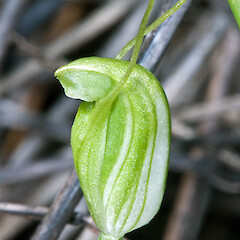Pterostylis puberula
Common name
dwarf greenhood
Synonyms
Pterostylis nana R.Br., Pterostylis nana auct. non. R.Br.; Rupp; Linguella puberula (Hook.f.) D.L.Jones, M.A.Clem. et Molloy
Family
Orchidaceae
Flora category
Vascular – Native
Endemic taxon
Indeterminate
Endemic genus
No
Endemic family
No
Structural class
Orchids
NVS code
The National Vegetation Survey (NVS) Databank is a physical archive and electronic databank containing records of over 94,000 vegetation survey plots - including data from over 19,000 permanent plots. NVS maintains a standard set of species code abbreviations that correspond to standard scientific plant names from the Ngä Tipu o Aotearoa - New Zealand Plants database.
PTENAN
Chromosome number
2n = (48), 50
Current conservation status
The conservation status of all known New Zealand vascular plant taxa at the rank of species and below were reassessed in 2017 using the New Zealand Threat Classification System (NZTCS) – more information about this can be found on the NZTCS website. This report includes a statistical summary and brief notes on changes since 2012 and replaces all previous NZTCS lists for vascular plants.
Please note, threat classifications are often suggested by authors when publications fall between NZTCS assessment periods – an interim threat classification status has not been assessed by the NZTCS panel.
- Conservation status of New Zealand indigenous vascular plants, 2017 . 2018. Peter J. de Lange, Jeremy R. Rolfe, John W. Barkla, Shannel P. Courtney, Paul D. Champion, Leon R. Perrie, Sarah M. Beadel, Kerry A. Ford, Ilse Breitwieser, Ines Schönberger, Rowan Hindmarsh-Walls, Peter B. Heenan and Kate Ladley. Department of Conservation. Source: NZTCS and licensed by DOC for reuse under the Creative Commons Attribution 4.0 International licence.
2017 | Threatened – Nationally Vulnerable | Qualifiers: EF, Sp
Previous conservation statuses
2012 | Threatened – Nationally Vulnerable | Qualifiers: DP, EF, Sp
2009 | Threatened – Nationally Critical | Qualifiers: EF, Sp
2004 | Threatened – Nationally Critical
Distribution
Endemic. New Zealand: Manawatāwhi / Three Kings Islands, North Island (from Te Paki to Hamilton Basin (Waikato) and southern Coromandel Peninsula, thence disjunct to Wellington (Taita Hills and near Eastbourne), South Island (North-west Nelson, near Westhaven). Since 1990 it has been reported only from Manawatāwhi / Great Island in the Manawatāwhi / Three Kings Islands, on the Hikurua / de Surville Cliffs (Te Paki) and from the Kauaeranga Valley, near Thames.
Habitat
Coastal to lowland on clay banks beneath light scrub, especially kahikatoa (Leptospermum scoparium), and gumland.
Detailed description
Slender orchid up to 200 mm tall, stem and foliage often somewhat chlorotic. Stem pale silvery-green to pale yellow-green, covered in minute, harsh tubercules, distinctly though irregularly, puberulent. Rosette leaves numerous, appressed; petiole distinctly though narrowly winged, 5–7 mm long; lamina 7 × 5 mm, silvery-green to pale yellow-green, ovate, acute. Cauline leaves, sparse, similar, sheathing. Flower solitary, silvery-white, striped green to pale green, set well above nearest bract. Dorsal sepal 10–15 mm, erect for ⅔ of length, then almost horizontal, apex obtuse to shortly acute. Lateral sepals fused, diverging widely, U-shaped in front view, then sharply contracted into long, slender, erect, filamentous caudae, these slightly clavate toward apex; caudae set well above galea. Petals = or longer than dorsal sepal sepal, subacute. Labellum oblong. Column longer than labellum; stigma long-oval, prominent.
Manaaki Whenua Online Interactive Key
Similar taxa
The silvery-green to pale yellow-green, often somewhat chlorotic appearance, compact, tightly appressed rosette leaves, distinctly though minutely harshly tuberculate and irregularly puberulent stem, largely devoid of cauline leaves, blunt-ended dorsal sepal, and filamentous, slightly clavate caudae set this species apart from all other New Zealand greenhoods.
Flowering
September–December
Flower colours
Green, White
Fruiting
September–January
Propagation technique
Difficult. Should not be removed from the wild
Threats
Habitat loss and degradation through weed encroachment, natural regeneration of forest species, and pig rooting are the main threats. Also, over-collection by botanists and orchid enthusiasts has occurred in the past.
Etymology
pterostylis: Winged column
puberula: With tiny hairs
Where To Buy
Not available.
TAXONOMIC NOTES
Jane et al. (2010) following a thorough rDNA (ITS) based analysis of the segregate genera erected for Pterostylis R.Br. by Szlachekto (2001) and Jones et al. (2002) found no support to continue their recognition. This view is followed here. Accordingly Linguella is treated as Pterostylis. Further, the claim to specific status for the New Zealand plant, which has variously been treated as conspecific with the Australian P. nana or as a distinct endemic P. puberula needs further critical evaluation. Pending further study P. puberula is retained for now as a distinct New Zealand endemic.
Attribution
Fact sheet prepared for NZPCN by P.J. de Lange 31 August 2006. Description based on de Lange et al. (2007).
References and further reading
de Lange P, Rolfe J, St George I, Sawyer J. 2007. Wild orchids of the lower North Island. Department of Conservation, Wellington, NZ. 194 p.
Janes JK, Duretto MF. 2010. A new classification for subtribe Pterostylidinae (Orchidaceae), reaffirming Pterostylis in the broad sense. Australian Systematic Botany 23: 260–269. https://doi.org/10.1071/SB09052.
Jones DL, Clements MA, Molloy BPJ. 2002. A Synopsis of the Subtribe Pterostylidinae. Australian Orchid Research 4: 129–146.
Szlachekto, D.L. 2001: Genera et Species Orchidalium 1. Polish Botanical Journal 46(1): 11–26.
NZPCN Fact Sheet citation
Please cite as: de Lange, P.J. (Year at time of access): Pterostylis puberula Fact Sheet (content continuously updated). New Zealand Plant Conservation Network. https://www.nzpcn.org.nz/flora/species/pterostylis-puberula/ (Date website was queried)


















